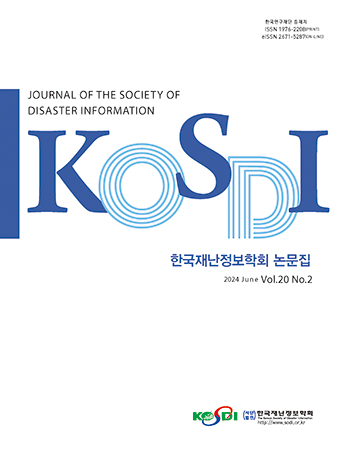Original Article
Abstract
References
Information
Purpose: The purpose of this study is to find a solution to the massive data construction that occurs when fire simulation data is linked to augmented reality and the resulting data overload problem. Method: An experiment was conducted to set the interval between appropriate input data to improve the reliability and computational complexity of Linear Interpolation, a data estimation technology. In addition, a validity verification was conducted to confirm whether Linear Interpolation well reflected the dynamic changes of fire. Result: As a result of application to the underground common area, which is the study target building, it showed high satisfaction in improving the reliability of Interpolation and the operation processing speed of simulation when data was input at intervals of 10 m. In addition, it was verified through evaluation using MAE and R-Squared that the estimation method of fire simulation data using the Interpolation technique had high explanatory power and reliability. Conclusion: This study solved the data overload problem caused by applying digital twin technology to fire simulation through Interpolation techniques, and confirmed that fire information prediction and visualization were of great help in real-time fire prevention.
연구목적: 본 연구는 화재시뮬레이션 데이터를 증강현실에 연동할시 발생하는 방대한 데이터 구축과 그로 인한 데이터 과부하 문제 해결 방안을 강구하기 위함이다. 연구방법: 데이터 추정 기술인 선형 보간법의 신뢰도와 계산 복잡도를 개선하기 위한 적정 Input 데이터의 간격을 설정하기 위한 실험을 진행하였다. 또한, 선형 보간법이 화재의 동적 변화를 잘 반영하는지 확인하기 위한 타당성 검증을 진행하였다. 연구결과: 연구 대상 건축물인 지하 공동구에 적용 결과 10m 간격으로 데이터 입력시 보간법의 신뢰성과 시뮬레이션의 연산처리 속도 개선에서 높은 만족성을 보였다. 또한, 보간법을 활용한 화재시뮬레이션 데이터의 추정 방식이 높은 설명력과 신뢰성을 가진다는 것을 MAE와 R-Squared를 이용한 평가를 통해 검증하였다. 결론: 본 연구는 화재시뮬레이션에 디지털트윈 기술을 적용하면서 발생하는 데이터 과부하 문제를 보간법을 통해 해결하였으며, 이를 통한 화재 정보 예측과 시각화가 실시간 화재 예방에 크게 기여함을 확인하였다.
- Choi, I.H. (2023). "Development of forecasting model for machine learning-based landfill leachate generation using linear interpolation." Journal of Korean Society of Environmental Engineers, Vol. 45, No. 1, pp. 11-20. 10.4491/KSEE.2023.45.1.11
- Fisher, R.A. (1975). Statistical Methods for Research Workers. Edinbergh, Oliver & Boyd, Scotland.
- Hong, S.Y, Min, S.H. (2018). "Data-driven fire accident analysis and developing prediction and corrsponding system using artificial intelligence." 2018 Korean Disaster Information Society Regular Symposium, Il-san, Korea, pp. 49-50.
- Kim, G.B. (2022). "Comparison of forecasting models for fire damage based on machine learning - Focusing on property and human damage." Journal of Knowledge Information Technology and Systems, Vol. 17, No. 4, pp. 647-655.
- Kim, J.S. (2020). "Development of fire detection model for underground utility facilities using deep learning: Training data supplement and bias optimization." Journal of the Korea Academia-Industrial Cooperation Society, Vol. 21, No. 12, pp. 320-330.
- Kim, J.Y, Min, S.H. (2023). "Study on horizontal and vertical temperature analysis of cable fire in common duct using room corner experiment." Journal of the Society of Disaster Information, Vol. 19, No. 3, pp. 634-643.
- Kim, M.S, Min, S.H. (2023). "A study on the adaptability of oxygen reduction system to fire in cold storage through fire simulation analysis." Journal of the Society of Disaster Information, Vol. 19, No. 1, pp. 117-127.
- Lee, D.H. (2022). "Analytical study on the prediction of fire evacuation time in large complex buildings using the ensemble learning technique." Journal of the Korean Society of Hazard Mitigation, Vol. 22, No. 5, pp. 9-17. 10.9798/KOSHAM.2022.22.5.9
- Lee, S.B, Min, S.H. (2023). "A study on the comparison of aspirating smoke detector and general smoke detector detection time according to the fire speed and location of logistics warehouse through FDS." Journal of the Society of Disaster Information, Vol. 19, No. 3, pp. 608-623.
- Seo, D.G. (2021). "A prediction model of casualties based on machine learning for selection of fire scenario." Journal of the Korean Society of Hazard Mitigation, Vol. 21, No. 5, pp. 165-173. 10.9798/KOSHAM.2021.21.5.165
- Seo, M.S. (2021). "Predictive analysis of fire risk factors in Gyeonggi-do using machine learning." Journal of the Korean Society of Surveying, Geodesy, Photogrammetry and Cartography, Vol. 39, No. 6, pp. 351-361.
- Son, B.S. (1997). Safety management of underground tunnels. KFPA, Disaster Prevention Technology No. 22, Korea.
- Publisher :The Korean Society of Disaster Information
- Publisher(Ko) :한국재난정보학회
- Journal Title :Journal of the Society of Disaster Information
- Journal Title(Ko) :한국재난정보학회논문집
- Volume : 20
- No :1
- Pages :82-92
- DOI :https://doi.org/10.15683/kosdi.2024.3.31.082



 Journal of the Society of Disaster Information
Journal of the Society of Disaster Information






